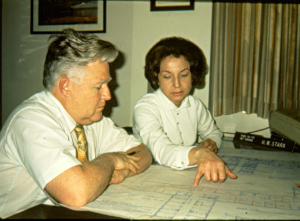
The Five Principals of PH&J circa 1975: L>R CH, John McDonald, Renis Jones, Bill Pearson and John Gandy.
Sister Susan called me to her office and shared the news sent down from Rome. She went on to say that PH&J could not be considered for the work. Following Tribrook’s lead, she declared that only architectural firms of national repute would be invited for an interview. To justify her position, she made a few disparaging remarks about my performance on the trash jobs I had been suffering, and my loyalty to this client was suddenly eroded. The main concern she expressed was our inability to exactly forecast the cost of the recent life safety renovations, which had to be estimated more on aggravation to the contractor than to actual construction quantities.
A few days later Administrator Susan advised me that PH&J might be considered as part of a joint venture with a new architectural firm from Houston. The Houston firm was called the Klein Partnership. It seemed that they were no larger than our firm, and that old man Irving Klein had recently been bought out by a hospital hot-shot named Jim Falick. Falick desperately wanted to get a new hospital job under the regime of his new ownership.

PH&J Associate David Hancock confers with Nurse Dial of St. Margaret’s. David filled a vital role for PH&J on this project.
Having been burned on virtually every joint venture we had ever undertaken before, I was reluctant about the proposed deal, but Renis and Bill were convinced we should reach an accommodation with the Klein group. In turn, I persuaded them that we should demand at least 50-percent of the job. By then, St. Margaret’s had been our client for almost 10 years and I had too much pride to take any less.
Falick and his cortege flew to Montgomery on May 18, 1976, and he immediately began to fawn over Sister Susan. His unctuous attitude toward her irritated yours truly, because I had refused to do so. I told Falick that PH&J would consider no arrangement in which we had less than a 50-percent part. Falick winced, but finally agreed in principle. As a new firm, he needed the job more than we did. Falick then proposed that I fly to Houston to see his operation and work out the details. Much against my better judgment I agreed to go.
I arrived in Houston on the 28th of May, and Jim Falick set out to dazzle me with his suavity and worldliness. His group had a 50/50 proposal neatly typed up and ready for my signature. They proposed to do half of the work (the far nicer and more profitable half, to be sure). We would open a joint checking account into which all fees collected would be paid. Each of us would draw from the account to pay our respective forces, and at the project end, the profit would be split 50/50. Falick eyed me expectantly.
After a long pause, I rejoined, “Jim, you must think I have picked too much cotton. Your part of the work goes first, you pay your troops more, you will have no incentive to be efficient, and there will be no profit left to split. In fact, there will not even be enough left in the account to pay my firm’s cost for its half of the work.” I continued, “I have a counter-offer.”
“Let’s split the work 50/50, and then split the gross fee 50/50. If you do your work efficiently, you will make a profit. If PH&J is efficient, we will make one. Neither of us will be forced to worry over the salary range or the efficiency of the other.” Falick thought it was a terrible idea. His associates were aghast, exclaiming that no one had ever forced them into that type joint venture deal before. “Take it or leave it,” I said and prepared to depart. They took it.
There remained several hours of fight in dividing the work into equal parts but we got through it and I returned to Montgomery. The following June 3rd the Klein/PH&J Joint Venture joined a half-dozen other firms in an interview process at the hospital. The selection process was orchestrated by the Tribrook Group from Chicago, brought in by Sister Susan to insure that only big-time operators would be considered. Jim Falick came in a day early, rehearsed all of us for 24 hours, and put on a classic “dog and pony” show for the selection committee. That type presentation was at least one thing that Falick and the Klein group did extremely well, and our joint venture won the day.
-Charles Humphries (“Peril and Intrigue Within Architecture”)
This is one of many St. Margaret stories. The rest can be found here.